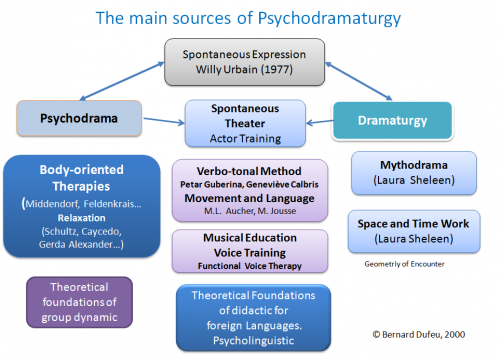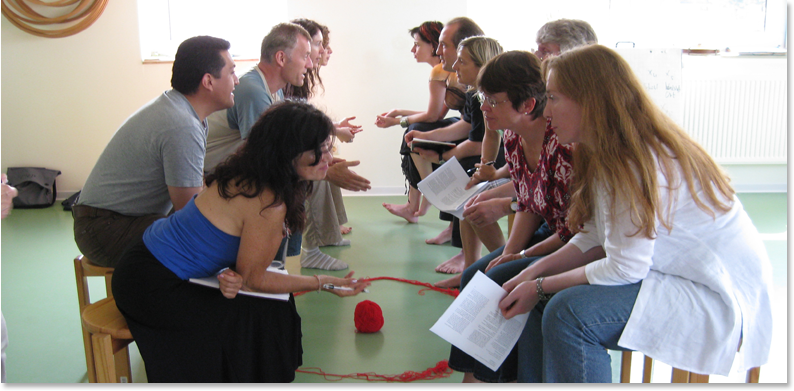Psychodramaturgy for Language Acquisition has been developed by Bernard Dufeu, University of Mainz, in collaboration with Marie Dufeu since 1977.
What first triggered the change of the orientation of my pedagogical work was a two week experiment in “Spontaneous Expression” conducted by Willy Urbain in July 1977 at the University of Mainz. This experiment made me question my concept of foreign language teaching without knowing where it would lead to. On the basis of this experience, I developed Psychodramaturgy for Language Acquisition with the help and support of my wife, Marie Dufeu. We then both took a training course in Psychodrama to learn its methods and to make a distinction between pedagogy and therapy.
The term "psychodramaturgy" refers to the two principal sources of this language learning method: psychodrama and dramaturgy, from which principles and techniques adapted for language learning were incorporated (see Dufeu, B. 1991a and b, 1992). These principles were adapted to foreign language teaching (see Dufeu, 1991 a and b, 1992, 1994, 1996, 1999, 2001, 2003) because it is not a question of doing therapy or theatre, but of gaining insights and techniques from these two areas and from others that can promote language acquisition.
PDL also consists of numerous warm-up and secondary exercises as well as oral and written exercises that we have developed since 1977. We have also developed methodological foundations that underpin their practice and enable them to form a coherent whole.
Despite the diversity of its sources, PDL is a coherent whole. To ensure an efficient language acquisition, PDL has been designed as an intensive course (between three and six hours every day) with a group of maximum fourteen participants. However, the basic principles and procedures and more than ninety-five percent of PDL can be used in other teaching contexts (extensive courses or larger groups).

The Psychodramatic Foundations of PDL
We owe psychodrama some theoretical principles and three procedures, which have been adjusted to fit foreign language education.
Theoretical Principles
Some fundamental concepts of psychodrama have been taken over in PDL:
- The concept of creative spontaneity: man is considered a creative being, and the subject of the learning process and not the object of a predetermined and fixed program. Warm-up processes are employed to foster creative spontaneity. Thus, the concept of the game is connected.
- The concept of the encounter: the language activities encourage the participants to develop relationships to one another. They meet on the real and the imaginary planes. The trainer meets the participant where he is at that moment with his personal needs and wishes and where he is linguistically. The language is primarily a means for communicating and relating and not just the objective of the lesson.
- The concept of the action: the participants acquire the foreign language in action and interaction ("drama" means "action")
- The global conception of man: the participants are addressed in their totality - physical, affective, intellectual and as members of a group (sociometric aspect) and in their spiritual dimension.
- The acquisition and learning process is seen as part of the overall development of the participant. Learning is a process of life and life is a continuous learning process. Learning and life are not separated. The acquisition of a foreign language contributes to the individuation of the participant (See Marie-Louise von Franz: "The process of individuation, " in CG Jung, Man and His Symbols, 1968, p. 158 - 229).
- Participant and group orientation: the participants are at the center of the acquisition process. The life of the group is taken into account by alternating between individual and group exercises during the first phases of PDL and in subsequent stages in the selection of activities and issues.
- The progression of the first four phases of PDL is based on the ontogenetic (individual developmental) progression Moreno sees in the doubling and mirroring exercises (JL Moreno: Group Psychotherapy and Psychodrama, Stuttgart: Thieme, 1959, p. 85-88). The symbolism of these phases and their sequence is carried over to PDL.
Technical Elements
Attitudes and procedures from psychodrama have been incorporated in the practice of psychodramaturgy:
- The empathic attitude of the trainer instead of the hierarchical attitude which prevails in traditional classrooms.
- The use of warm-up exercises: each main exercise is preceded by a warm-up exercise, which prepares the required position for the main exercise and its implementation.
- The doubling and the role exchange as well as Moreno’s conception of the role play with its accompanying techniques (interview, soliloquy ...) were sometimes directly and sometimes in modified form adopted by us.
- The principle of mirroring: the mirror exercise in PDL is very different from that in the psychodrama. It als serves another function (see Dufeu Bernard: Towards a Pedagogy of Being, p. 67 and 160-170).
- The structure of the morenean roleplay.
- Aspects of group management: the trainer provides a framework and structures the phases of the activities (it is not a laissez-faire style), the participants determine the content. The trainer then supports them in language, when and if they need it.
Psychodramaturgy tries among other things, to achieve a goal that Moreno (in 1973) expressed as follows:
"The reproductive process of learning must move into second place; first emphasis should be given to the productive, spontaneous-creative process of learning. The exercise and training of spontaneity is the chief subject of the school of the future.”
(Moreno, Jakob Levy: Group Psychotherapie and Psychodrama, 1973, S. 81)
As this future has already begun for us, we can call the PDL a psychodramatic pedagogy.
The dramaturgical foundations of PDL
To avoid any misunderstanding, it is important to clarify that the term "dramaturgical" is not to be understood in the sense of "theatrical". This is not about doing classical theater, which would mean the participants learning and rehearsing a certain text and then performing it. It is about employing certain dramaturgical principles underlying the dramaturgy of the plays that evoke a certain response from the public.
- The dramaturgical functions: The setup of the main exercises of PDL is based from the outset on the use of dramatic elements. From the six functions of the dramaturgy, as described by Souriau (see Emile Souriau: Les deux cent mille situations dramatiques, 1950), we took over only three that seemed to us relevant to pedagogy. We have given these functions terms that are better adapted to our work. They are the Wish, the Opposition and the Support. The combination of these functions is also considered in the selection of topics and texts.
- The principle of dramaturgical resonance in the selection of topics, texts, and in the preparation of the setting.
- The use of neutral masks in the first four days of intensive course we owe to Willy Urbain. These masks promote concentration, receptivity, and auditory perception and also have a protective function.
- To build up dramaturgical situations, we also use principles of spontaneous theater by J.L. Moreno, methods of Mythodrama of Laura Sheleen and the “space and time” exercises she developed (See Laura Sheleen, 1983; Jacques Dropsy, 1973). For one exercise, we use the technique of "Forum Theatre” of Augusto Boal (see Chapter V).
- We also use as in-between exercises in the language and trainer training courses several exercises taken from actor training. These exercises encourage the spontaneity and creativity of the participants.
The other sources of PDL
Laura Sheleen had a great influence on our conception of life and humanity. She sensitized us to the work with the mythology and its symbolic meaning, (Sheleen L. 1983 and 1987) as well as to aspects of her “space and time” work (see Jacques Dropsy, 1973, 1984).
Theoretical foundations of group dynamics helped us to make the structure and progression of the exercises in the first days of an intensive course (see Dufeu Bernard: Towards a pedagogy address of Being, Chapter III, IV and V) and contributed to our perception and selection of group topics in the advanced courses (see Anzieu, 1983, 1984).
Geneviève Calbris (CREDIF, France) and Petar Guberina (University of Zagreb) introduced us to the verbo-tonal method that emphasises the importance and the method of pronunciation correction especially at the beginning of a beginner course.
We also draw on methods from the field of voice training and musical education. Some vocal exercises come from the work of Marie-Louise Aucher (See also, M.L. Aucher, 1977a, b). The gestures accompanying poems and texts are based on the work of Marcel Jousse. The techniques were taught to us by his assistant Gabrielle Baron (see Baron, G, 1981, Jousse, M., 1974a, b). Exercises and methods of functional voice therapy are also incorporated into our work.
We have also taken up exercises from the "expression corporelle" or body-oriented methods (see Dufeu Bernard: Towards a Pedagogy of Being, Chapter III and IV).
The relaxation techniques are based on principles of Eutonie of Gerda Alexander, Sophrology of Alfonso Caycedo, and autogenous training of JH Schultz. For the breathing techniques, we thank Ilse Middendorf (See Middendorf, I, 1984) and one of her students, Helga von Hochberg (See Dufeu Bernard: Wege zu einer Pädagogik des Seins, Chapter IX).
Theoretical foundations of foreign language teaching, psychology of learning, and psycholinguistics also contributed to the theoretical foundations of PDL.
One should not confuse the sources with the means and objectives.
All these sources have been adapted to the educational needs of foreign language instruction, in the same way as athletes and artists, adopt methods and techniques from other disciplines (Relaxation exercises, concentration, visualization techniques ...) to increase their performance or perception. They enrich Psychodramaturgy for Language Acquisition and contribute to its effectiveness and overall coherence.
Excerpts from: Wege zu einer Pädagogik des Seins
(Towards a pedagogy of being). Mainz: 2003, 59-74.
© Bernard Dufeu, 2001
Last changed: 10 March 2009
Translation: Robert Zammit






